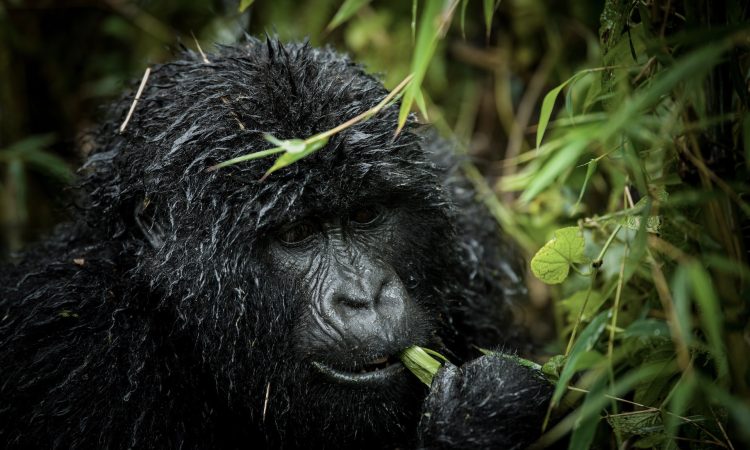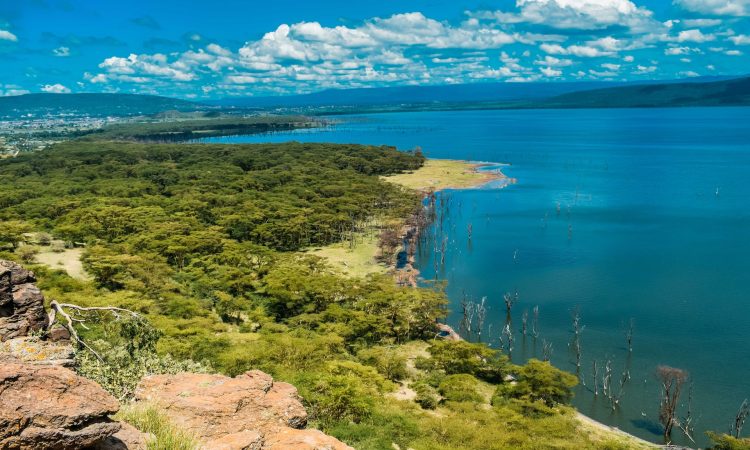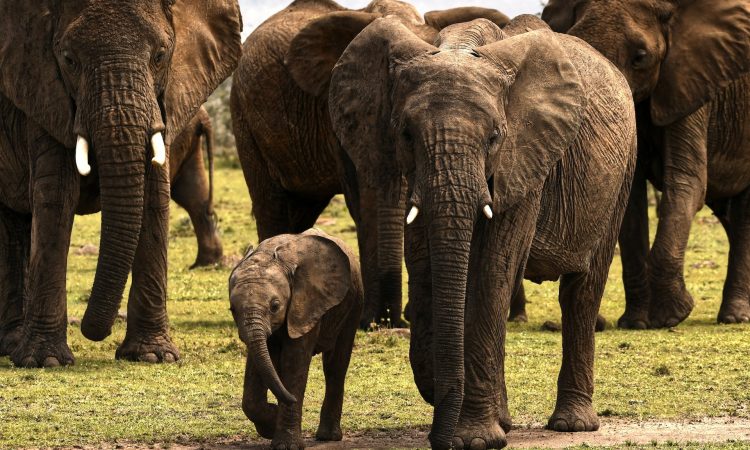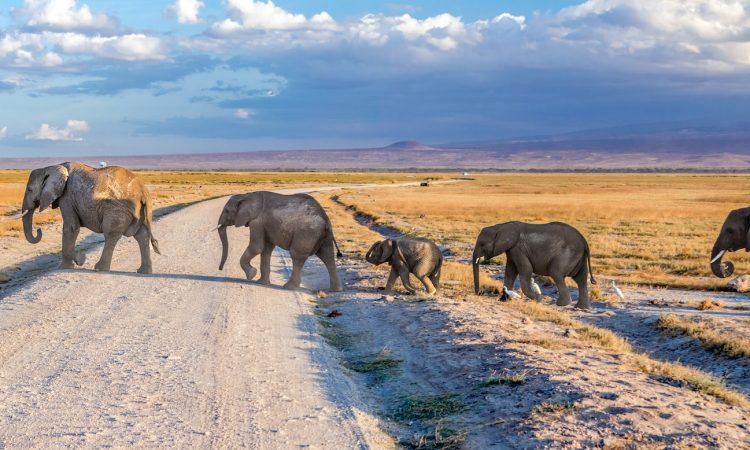Want to experience the annual great wildebeest migration?
When many people think of Africa, they think of Kenya and Tanzania because the two neighboring countries are among the top tourist destinations in the world.
Tanzania boasts 22 unique national parks and is home to Africa’s highest mountain, attracting over 50,000 tourists annually, while Kenya has 24 national parks and is also home to Mount Kenya, the second-highest mountain in Africa.
Both countries have diverse ecosystems supporting millions of wildlife.
The most famous national parks in both countries are the adjacent Masai Mara National Park in Kenya and Serengeti National Park in Tanzania.
Wildebeest Migration Map

About the Migration
Want to witness the annual great wildebeest migration experience in Africa?
Whether it is Serengeti migration safaris or Masai Mara migration safaris, we are willing to organize for you an unforgettable experience.
The wildebeest migration occurs in East Africa, across Serengeti National Park in Tanzania and Masai Mara National Reserve in Kenya.

This migration is also sometimes known as the Gnu migration.
Over 1.5 million animals participate in the migration in search of water and pasture, including mainly wildebeests accompanied by zebras, topis, Grant’s gazelles, impalas, Thompson’s gazelles, and elands.
Predators such as lions, crocodiles, hyenas, cheetahs, wild dogs, leopards, and many others keep track of the herds in order to hunt for prey.
This is the largest migration of animals in the world.
See some of our most popular wildebeest migration safari packages below:
About Wildebeests
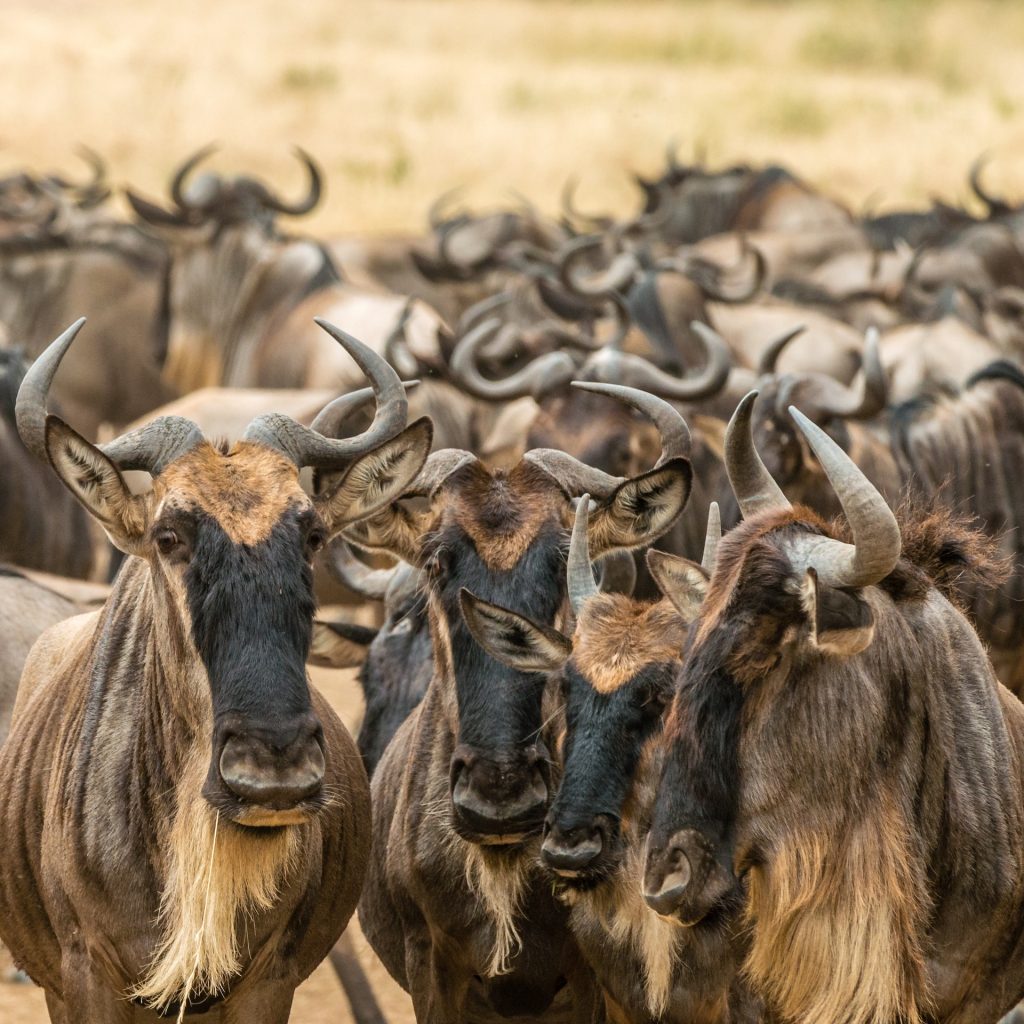
Wildebeests are also known as “gnu” and belong to the antelope family.
The name is derived from the Afrikaans language, meaning “wild beast.”
There are two species of wildebeests: the blue wildebeests and the black wildebeests.
Wildebeests can only be found in East and South Africa, with the largest population found in Kenya and Tanzania.
They commonly communicate through sight and smell but can also become vocal.
They are territorial animals, with herds owning about 1.5 square kilometers.
They are herbivorous animals, preferring mainly grass but can also eat leaves when grass isn’t available.
The gestation period of wildebeests is 8 to 8 and a half months, and the calves are born weighing between 20-22 kilograms.
The mother takes about 6 to 9 months to wean the calf, and the calves will be ready to mate between 16 to 76 months.
The average lifespan of a wildebeest is 20 years old. They can grow up to 2.4 meters in length and weigh 270 kilograms.
Migration in Kenya – Masai Mara

Though the migration takes place all year round at points, the migration in Kenya coincides with the peak tourism season.
The wildebeest migration in Kenya takes place at the famous Masai Mara National Reserve.
Larger herds of wildebeests start arriving at Masai Mara in mid-July until the end of August and then start declining in September.
There are specific and common points where experienced safari drivers will guide you through.
The very best time for seeing the migration or river crossings isn’t predictable, but given the experience and observation over the past years, mid-July to late August provides the highest chances of spectacular crossings.
In late October, the wildebeests start to disperse back slowly to Serengeti National Park in Tanzania.
Masai Mara National Park is also a potential birding area in Kenya, which boasts over 500 species of birds recorded.
Therefore, bird enthusiasts should not miss a day birding.
Some of the birds you will find include rare shoebill storks, grey crowned cranes, Madagascar squacco heron, rufous-bellied heron, saddle-billed stork, Goliath heron, Kori bustards, secretary bird, jaunty crowned plovers, great white egret, black-headed heron, fisher’s turaco, red-throated tit, martial eagle, tiny pygmy falcon, African finfoot, common ostrich, southern ground hornbill, Tabora cisticola, woolly-necked stork, yellow-throated sandgrouse, trilling cisticola, white-bellied go-away bird, Swahili sparrow, Abdim’s stork, grey penduline stork, Jackson’s widowbird, and purple grenadier, among others.
Migration in Tanzania – Serengeti
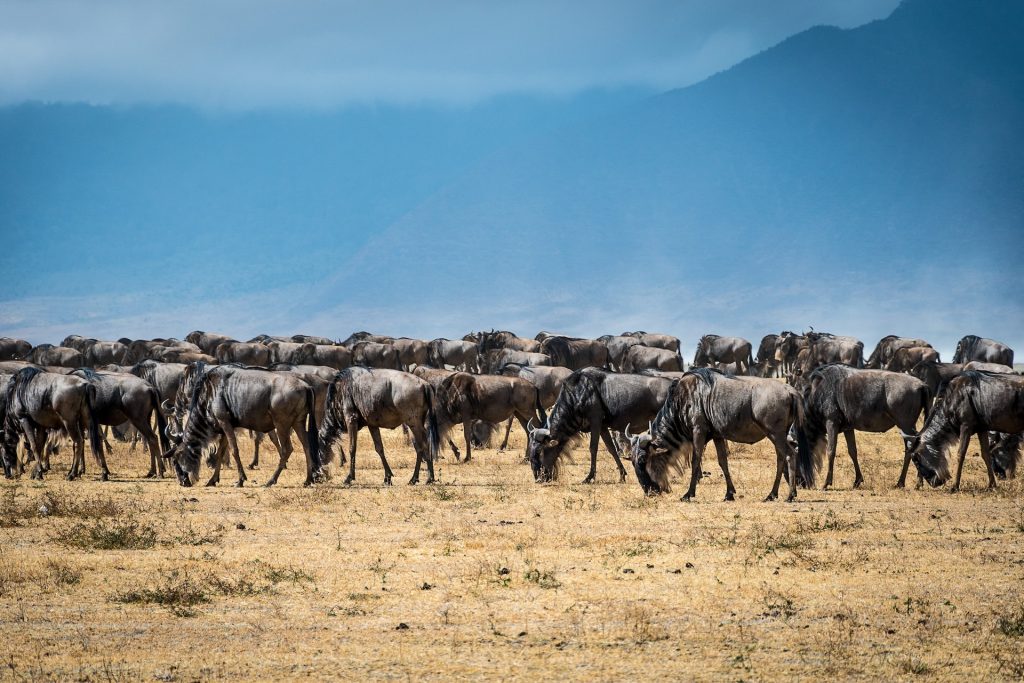
Before wildebeests cross to Masai Mara National Park, they graze around Ngorongoro and Ndutu plains south of Serengeti National Park between December to April.
In May to March, the herds start migrating to the northern part of the park in search of better pasture and water.
By the end of June, the herds will be crossing the Grumeti River, depending on the water levels, but you can have chances of seeing the crossing and also watch crocodiles preying on some animals.
From July to August happens the biggest show of the wildebeest migration as they cross from Serengeti National Park to the Mara River, though some herds remain in the northern parts of Serengeti.
From October to November, the herds start migrating back to Serengeti through Lobo area of the park.
January to March is normally the calving season.
Serengeti National Park is also a birder’s paradise with several species of birds.
Some of these examples are grey-breasted spurfowl, rufous-tailed weaver, Usambiro barbet, grey-crested helmet-shrike, red-capped robin chat, Masai ostrich, silverbird, Schallow’s turaco, southern ground hornbill, Tabora cisticola, woolly-necked stork, yellow-throated sandgrouse, black-necked gonolek, Fischer’s lovebird, grey-backed fiscal, Usambiro barbet, green-backed woodpecker, African pygmy goose, yellow-billed duck, mourning collared dove, helmeted guineafowl, African jacana, great white pelican, osprey, secretary bird, bearded vulture, wood sandpiper, bat hawk, hammerkop, common buzzard, African marsh harrier, masked weaver, and southern red bishop, among the rest.
Migration Routes

- Ngorongoro Conservation Area and Ndutu Plains. In January to March, the wildebeests are found in Ngorongoro Conservation Area and Ndutu Plains of Serengeti National Park in Tanzania.This is also a calving season where approximately 8,000 wildebeests are born while predators are ever-present to take advantage of the young calves.
- Central and Western Serengeti. The wildebeests move to the central and western regions of Serengeti in search of fresh pasture and water.
- Grumeti River. The herds move south of the Grumeti River in June, preparing to cross over.
- Mara River. Herds around the Grumeti Reserve are then ready for the most challenging part of the journey in mid-July, crossing the Mara River where thousands of crocodiles lie in wait for an opportunity to prey on wildebeests. This is the most dramatic part of the wildebeest migration.
- Masai Mara National Reserve. From July to August, millions of wildebeests have already crossed to Masai Mara National Reserve in Kenya. This is the best place for viewing the migration at this time of the year.
- Masai Mara National Reserve and Serengeti National Park. Not all wildebeests cross to Masai Mara Game Reserve; therefore, you will find some grazing at the northern plains of Serengeti while some are in Masai Mara National Reserve, and others are still crossing in September.
- Western Loliondo and Lobo Area. In the month of October, herds are concentrated at Masai Mara National Reserve and then start moving southwards through western Loliondo and Lobo areas to the fertile plains of Serengeti National Park.
- Serengeti National Park. The herds have just arrived back from a very long journey and graze across Serengeti fresh plain pastures and water in December, waiting for the calving season and for the circle to restart once more.
Best Time to See the Migration

The migration takes place throughout the year as their movements are dictated by weather.
This somehow makes their movements detectable because the two countries have almost the same seasons year in and year out.
In January, the herds are mainly concentrated in the southern part of Serengeti National Park in Tanzania in areas around Lake Ndutu.
Between February and March, thousands of wildebeest babies are born every single day.
This is quite interesting as you witness calves being born but can sometimes become heartbreaking when predators hunt the newly born calves immediately.
Around 600,000 calves are born during this time.
April to May is the beginning of the long rainy season, and the herds move to the northwestern direction around the Kopjes of Simba and Moru.
At the end of May, they move a bit faster as the recently born calves are strong; hence, herds subdivide into thousands and hundreds of columns.
In June, the herds are now in central Serengeti getting ready to cross the Grumeti River or even some crossing already.
In July, the survivors are now in the grazing around the Grumeti Plains getting ready to cross the great Mara River over to Masai Mara National Reserve.
August is when the crossing at the Mara River is intense and considered the best time for watching river crossings for those interested.
In September and October, the wildebeest mega-herds are now grazing at the Masai Mara Plains, and this is the best place for seeing the migration in the year, though some herds remain in Tanzania, but the largest are in Kenya at this time of the year.
November is the beginning of the short rainy season, and at this time, the wildebeests are now preparing to go back to Tanzania.
They usually split into smaller groups and move to the northeastern parts of Serengeti before heading south.
December gets the wildebeests at Serengeti grazing plains, waiting for January to again start the journey to the unknown.
Migration Seasons

March to July
After calving in Ngorongoro Conservation Area and Ndutu Plains of Serengeti National Park, the herds start moving towards the north to the Grumeti Reserve, preparing to cross over to Kenya.
Most predators follow the herds closely, interested in young calves.
July to August
The most distinctive season of the migration is mid-July to August when the herds start crossing the Mara River to Masai Mara National Reserve in Kenya.
This is the best time to witness river crossings and watch the most spectacular wildlife show on earth.
October to November
Wildebeests migration herds start to leave Masai Mara Game Reserve via Lobo area and Looliondo, heading back to Serengeti National Park.
Migration Facts

It’s estimated that each animal covers about 800 to 1,000 kilometers during the migration.
The circuit starts from southern Tanzania around the Ngorongoro Conservation Area through Serengeti National Park and finally crossing to Masai Mara National Park in Kenya before going back.
The three main migrant groups have different eating habits, with the first group eating the upper parts of the tallest grasses, the second group fond of medium-height grasses, and the last group preferring the underneath.
Though some experts say that the animals follow lightning and thunderstorms, it’s unknown why wildebeest keep on migrating, but it’s assumed that they do so in response to weather as they follow the rains and fresh grass.
It’s estimated that over 250,000 wildebeests die during the migration, resulting from predators, hunger, thirst, and exhaustion.
Zebras and wildebeests coexist together since they eat different parts of the same vegetation.
Adding Gorilla Trekking to Your Trip

Mountain gorillas are an endangered species of primates endemic to Bwindi Impenetrable National Park, and the Virunga mountain ranges, straddling across Uganda, Rwanda, and the Democratic Republic of Congo.
They cannot live in captivity but only in their natural habitat, and the gorillas you see at the zoo are western lowland gorillas.
There are few mountain gorillas left in the wild, although conservation efforts have seen the population increase in recent years.
They have a gestation period of about eight and a half months, with 2-3 fertile days in a month.
A female mountain gorilla gives birth to 4-6 offspring in a lifetime.
The baby mountain gorillas are vulnerable when born and are weaned by their mother.
They sleep in their mothers’ nests until the age of four when they start making their own nests close to their mother’s nest.
Mountain gorillas make new nests every day, though a new home can be close to the previous one.
Mountain gorillas live in families led by a dominant adult male known as a silverback, who protects and organizes all group activities, such as where to forage.
The silverback is also the only gorilla with mating rights in the group.
Sometimes, when blackback gorillas grow, they engage in serious and dangerous fights to dominate the group, which can lead to serious injuries or even death.
The defeated silverback can leave the group and become a lone silverback, or sometimes the blackback can take some members of the group, especially females, to start their own family.
Kenya borders Uganda, while Tanzania borders Uganda and Rwanda.
Uganda and Rwanda are two of the three countries where gorilla trekking can take place in the whole world.
Uganda is home to half the population of world mountain gorillas and also offers moderate prices for gorilla trekking, attracting budget and mid-range travelers.
Rwanda, on the other hand, charges the highest amount for gorilla trekking, intended for luxurious travelers.
Mountain gorillas are an endangered species of primates found in Uganda, Rwanda, and the Democratic Republic of Congo.
They are close human relatives, sharing 98% DNA.
You can add gorilla trekking to your wildebeest migration trip to Kenya or Tanzania for a thrilling experience.
The Mara Grumeti River

The Grumeti River is located along the western corridor of Serengeti National Park in Tanzania, around the Mara region.
It flows westwards into the renowned Lake Victoria.
The crocodile-infested river is where one of the most dramatic wildlife shows on earth takes place year after year.
The great wildebeest migration herds usually cross and stay around the Grumeti River from late May to early July.
The exact dates of the crossings cannot be predicted but entirely depend on the water levels and weather changes because the crossing normally occurs when the long rainy season transitions into the dry season.
The river is located in a remote area of Serengeti and can be reached by car or through Grumeti airstrip.
Visit Masai People

Apart from the wildebeest migration in Masai Mara and Serengeti National Park in Tanzania, you can visit the famous Masai people who also live in both countries.
The Masai people have a very rich and vibrant culture, and they have coexisted with wildlife for several years.
Get to know the people and their way of life.
You can support the community by engaging in their day-to-day life activities like cattle grazing, cooking local food, watching them perform their traditional dances, or buying beautiful souvenirs to take back home for remembrance.
Wildebeest Migration Video
Useful links:
- https://education.nationalgeographic.org/resource/wildebeest-migration/
- https://en.wikipedia.org/wiki/Wildebeest
Featured in: Kenya Attractions, Kenya Information, Tanzania Attractions, Tanzania Information


